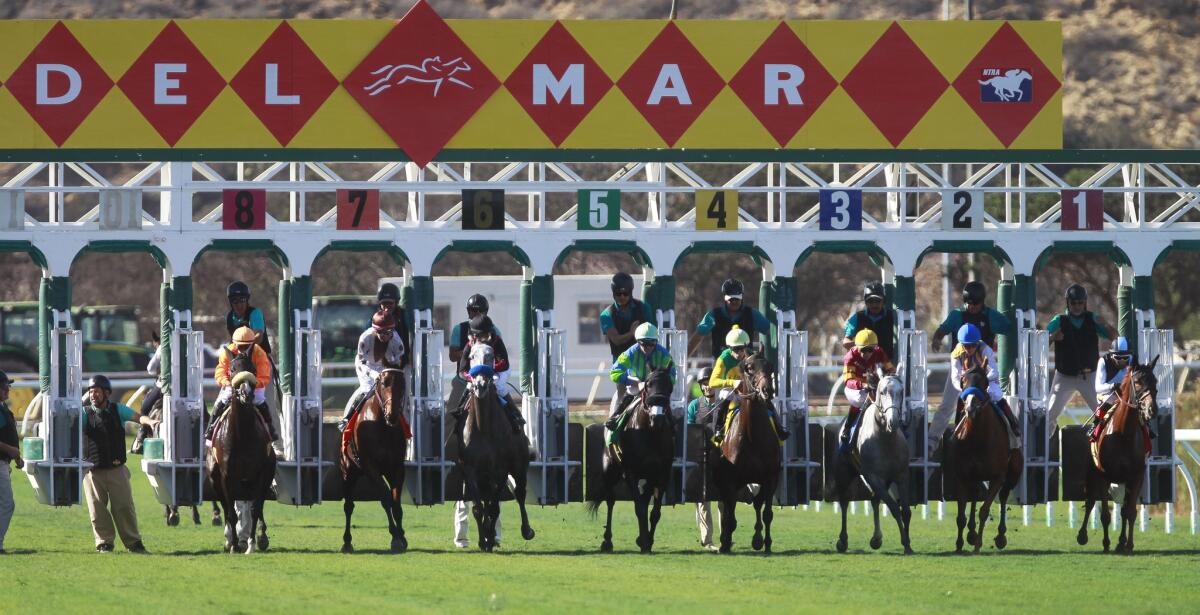Del Mar, ‘Where the turf meets the surf,’ has a new slogan for summer meeting

- Share via
It is not a slogan that will be plastered on billboards around San Diego. No one is going to create jazzy theme music for it.
Yet the Del Mar Thoroughbred Club has an urgent message it wants to communicate to patrons:
“We are not Santa Anita.”
After 30 horse deaths occurred during the winter-spring meet at the historic track at the foot of the San Gabriel Mountains, focusing a white-hot national spotlight on the issue of thoroughbred horse treatment and safety, increased attention will be trained on Del Mar as its 80th summer meet commences Wednesday.
“I know that the opening of Del Mar will not be about hat contests, pretty people and concerts; it’s going to be about dead horses,” Joe Harper, Del Mar’s CEO said solemnly. “Hopefully, if what we’re doing will come to light, I think we will be impacted less than Santa Anita was.”
In the wake of racing reforms introduced during the Santa Anita meet at the urging of state lawmakers and the California Horse Racing Board (CHRB), people inside and outside the industry say scrutiny of the industry is at an all-time high. Owners and trainers say a significant number of deaths at any future meet could threaten the sport in California.
“This is a tipping point,” said Josh Rubenstein, Del Mar’s COO and president.
Those who want to see horse racing abolished in the U.S. say the recent reform efforts have not gone far enough.
“I look at these reforms as a massive ruse. I see the horse racing industry as depressed and scrambling because of Santa Anita,” said Patrick Battuello, founder of the organization Horseracing Wrongs, which has been tracking racing deaths on its website since 2013.
“They have to give the public something as a show of good faith, that they are taking this seriously.
“I do feel that we’ve turned the corner here with Santa Anita. The national press is finally engaged. They are seeing, in fact, that what happened at Santa Anita isn’t an anomaly. This wasn’t a ‘spike’ or ‘spate.’ This was business as usual.”
According to Jockey Club Equine Injury Database statistics, there have been 155 reported racing deaths (not including training) at Santa Anita in eight calendar years from 2011 to 2018, an average of 19.3 per year. Del Mar has had 54 reported racing deaths (an average of 6.75) in that span in staging 39,821 fewer races.
In the last two seasons of summer and fall racing combined, Del Mar suffered 15 horse deaths and has been the safest major track in the country, according to the Jockey Club.
After a catastrophic 2016 in which 23 horses died in racing or training during summer and fall, Del Mar revamped its dirt running surface and instituted stronger safety initiatives — some of which were adopted and then enhanced by Santa Anita in the latter portion of its recent meet.
Del Mar will use those new measures and is adding to its veterinary staff to step up the scrutiny of horses before they train or race.
“The numbers are very good, and they’re not good enough,” said Craig Dado, Del Mar vice president and chief marketing officer. “So we brought in new protocols for this year, and the goal is to get as close to zero [deaths] as we possibly can.”
There were six deaths at Del Mar last summer, and since the inception of the Jockey Club Equine Injury Database in 2009, the fewest deaths in a single meet at the seaside track were two during racing in 2013, when there was a synthetic running surface.
“I think they understand there will be horse deaths at Del Mar this summer,” Harper said of the communications the track has had with representatives of Gov. Gavin Newsom and Sen. Dianne Feinstein, who both pushed for racing reforms as the Santa Anita deaths mounted.
I know that the opening of Del Mar will not be about hat contests, pretty people and concerts; it’s going to be about dead horses.”
— Joe Harper, CEO of Del Mar Thoroughbred Club
Feinstein twice called for racing at Santa Anita to be halted — first on April 2 after the 23rd horse death there, and again on June 10 after six more horses died in a 23-day span.
Though Santa Anita suspended three weeks of racing in March, it refused to shut down in June after the 28th and 29th deaths, despite the urging of Feinstein, Newsom and the CHRB.
The California Legislature hurried to pass a bill in late June that gives the CHRB the power to close a meet at any time for the safety of riders and horses. The CHRB also formed, at Newsom’s request, a five-member panel that will examine the past performances and workouts of prospective racers, including at Del Mar.
“They are very concerned and want to make sure that we’re doing everything we possibly can to not be Santa Anita,” Harper said. “In answering their inquiries, we’ve said, ‘Here’s what we’ve done, here’s what we’re doing, and here’s where we stand in the big picture of things.’ There is a comfort for them in that.”
As she has for the past eight years, San Diego animal protection activist Ellen Erickson will occupy a visible spot in front of the gates at Del Mar and likely will be joined by other protesters.
Erickson, who uses Horseracing Wrongs literature but is not officially affiliated with the group, has led protests against SeaWorld, the San Diego Zoo and the San Diego County Fair.
“For me, one dead horse is too many,” Erickson said. “It’s time to abolish horse racing. It’s a cruel form of entertainment. If someone was whipping any other animal in front of 10,000 people, they’d get arrested.”
Trainer Jim Cassidy, past president of the California Thoroughbred Trainers, said Del Mar is under a finely focused microscope.
“The critics are just waiting for something to happen — hoping for something to happen,” Cassidy said. “That’s the saddest part.”
“The numbers are very good, and they’re not good enough. ... The goal is to get as close to zero (deaths) as we possibly can.”
— Craig Dado, Del Mar vice president and chief marketing officer
Del Mar will not immediately see high-profile protests from PETA, the largest animal rights organization in the country. Kathy Guillermo, PETA senior vice president, said PETA wants to give Del Mar the opportunity to enact the new measures and gauge the results.
Guillermo said she believes that racing should be working toward a zero-death rate at meets.
“There is no reason for a horse to die for entertainment purposes,” she said. “Accepting deaths is saying you’re losing the battle without bringing out the big guns.”
Del Mar is quick to point out differences between its operations and those at Santa Anita.
The Stronach Group (TSG), which owns Santa Anita, is a publicly traded, Canadian-based entertainment and real estate company that owns and manages a number of racetracks in North America. Some of their tracks feature slot machines, as well as off-track betting facilities.
Before the horse deaths at Santa Anita, the biggest headlines TSG produced were about the bitter and litigious family feud over control of the company between current TSG Chairman Belinda Stronach and her father, Frank.
Del Mar operates as part of the 22nd District Agricultural Association, which also oversees the Del Mar Fairgrounds and the San Diego County Fair. In reporting to the DAA, Del Mar operates not for profit, and beyond paying its employees, it puts its earnings back into rent payments and facility maintenance and upgrades.
DMTC reports that since its inception in 1970, it has paid $432.7 million to the state, $345.5 million to the Del Mar Fairgrounds, and $25.4 million to California municipalities, including $10.2 million to the city of Del Mar. It said it has contributed $66.4 million to equine research and breeding, and $8.8 million to charity.
It also continues to pay off more than $41 million in bonds for the overhaul of the track grandstand in 1991, a bill that can reach $3 million per year.
Harper pointed out that after Del Mar’s 2016 season, in which 23 horses died, the DMTC board approved spending $1.5 million to renovate the track.
“The decisions we made two years ago cost us quite a bit of money,” Harper said. “Those were million-dollar swings. And I tell you that our board never felt better about losing money. In reality, Del Mar does very well, and the reason we do very well is that we don’t take any money out. That’s different from a lot of other tracks.”
Horse owners say they see the distinction as well.
“There is a massive difference between the approach taken by a for-profit operator and a not-for-profit operator,” said Thoroughbred Owners of California President and CEO Greg Avioli, who served as president and CEO of the Stronach Group for one year in 2011-12.
At Santa Anita, horsemen have complained of hard-line tactics by management in pressuring them to race horses. This winter, when Santa Anita was hit with 11½ inches of rain in a two-month span, management struggled to find a solution to track conditions, and 19 horses broke down in that time frame.
In March, Belinda Stronach announced in an open letter sweeping changes in the way horses would be medicated and examined at Santa Anita. The action was welcomed by many in the industry as long-needed reform, but it took some veteran horsemen by surprise.
While supporting the new measures, Del Mar officials said they have spent the last couple of months seeking to quell concerns about racing in California.
“Under some challenging times, we’re trying to add some normalcy and stability into Southern California,” said Tom Robbins, Del Mar executive vice president of racing and industry relations.
Robbins said more than 600 horses shipped out of California during the Santa Anita crisis, and that Del Mar can expect to see entries down by as much as 15% overall and at least 20% for 2-year-olds. Still, Del Mar is hoping to maintain racing five days a week and cut only a few races.
“If we can run 40 races a week (down from 43 last summer) that’s a huge success,” Robbins said. “The other part is that if we have all six-horse fields, we’ll be disappointed. We still have to have attractive wagering cards. That’s obviously what fuels the business and fuels the purses.”
It is unclear what effect the Santa Anita situation may have on Del Mar’s attendance. Attendance at all tracks in America has been dropping steadily for years, and Del Mar hasn’t been immune.
According to a Fitch Ratings analysis published this year, attendance at Del Mar has slipped by some 175,000 per meet over the last 12 years. The track has worked to stanch its losses with promotions that appeal to more casual fans. This summer, it has 10 concerts scheduled, along with food festivals and family weekend activities.
Will casual fans be turned off if they fear carnage on the track?
“We’re very concerned,” Dado said. “Research has shown that those people are more affected by this. It’s our job to basically get out the information that we’re not Santa Anita. We are among the safest tracks in the country, and we expect to get even safer.”
More to Read
Go beyond the scoreboard
Get the latest on L.A.'s teams in the daily Sports Report newsletter.
You may occasionally receive promotional content from the Los Angeles Times.










